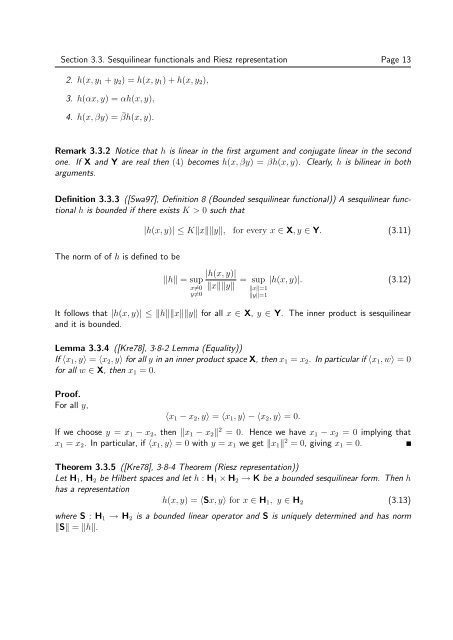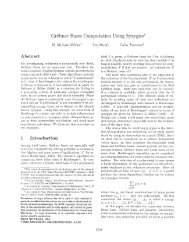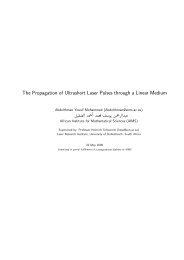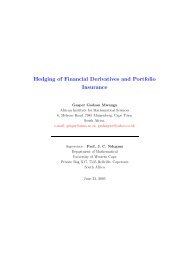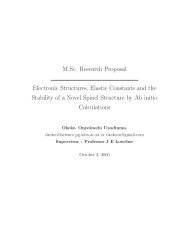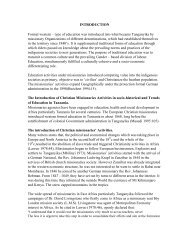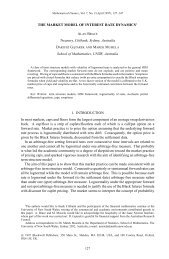Operators on Hilbert Spaces - user web page - AIMS
Operators on Hilbert Spaces - user web page - AIMS
Operators on Hilbert Spaces - user web page - AIMS
Create successful ePaper yourself
Turn your PDF publications into a flip-book with our unique Google optimized e-Paper software.
Secti<strong>on</strong> 3.3. Sesquilinear functi<strong>on</strong>als and Riesz representati<strong>on</strong> Page 13<br />
2. h(x, y1 + y2) = h(x, y1) + h(x, y2),<br />
3. h(αx, y) = αh(x, y),<br />
4. h(x, βy) = ¯ βh(x, y).<br />
Remark 3.3.2 Notice that h is linear in the first argument and c<strong>on</strong>jugate linear in the sec<strong>on</strong>d<br />
<strong>on</strong>e. If X and Y are real then (4) becomes h(x, βy) = βh(x, y). Clearly, h is bilinear in both<br />
arguments.<br />
Definiti<strong>on</strong> 3.3.3 ([Swa97], Definiti<strong>on</strong> 8 (Bounded sesquilinear functi<strong>on</strong>al)) A sesquilinear functi<strong>on</strong>al<br />
h is bounded if there exists K > 0 such that<br />
The norm of of h is defined to be<br />
|h(x, y)| ≤ Kxy, for every x ∈ X, y ∈ Y. (3.11)<br />
|h(x, y)|<br />
h = sup<br />
x=0 xy<br />
y=0<br />
= sup<br />
x=1<br />
y=1<br />
|h(x, y)|. (3.12)<br />
It follows that |h(x, y)| ≤ hxy for all x ∈ X, y ∈ Y. The inner product is sesquilinear<br />
and it is bounded.<br />
Lemma 3.3.4 ([Kre78], 3·8-2 Lemma (Equality))<br />
If 〈x1, y〉 = 〈x2, y〉 for all y in an inner product space X, then x1 = x2. In particular if 〈x1, w〉 = 0<br />
for all w ∈ X, then x1 = 0.<br />
Proof.<br />
For all y,<br />
〈x1 − x2, y〉 = 〈x1, y〉 − 〈x2, y〉 = 0.<br />
If we choose y = x1 − x2, then x1 − x2 2 = 0. Hence we have x1 − x2 = 0 implying that<br />
x1 = x2. In particular, if 〈x1, y〉 = 0 with y = x1 we get x1 2 = 0, giving x1 = 0.<br />
Theorem 3.3.5 ([Kre78], 3·8-4 Theorem (Riesz representati<strong>on</strong>))<br />
Let H1, H2 be <strong>Hilbert</strong> spaces and let h : H1 × H2 → K be a bounded sesquilinear form. Then h<br />
has a representati<strong>on</strong><br />
h(x, y) = 〈Sx, y〉 for x ∈ H1, y ∈ H2<br />
(3.13)<br />
where S : H1 → H2 is a bounded linear operator and S is uniquely determined and has norm<br />
S = h.


